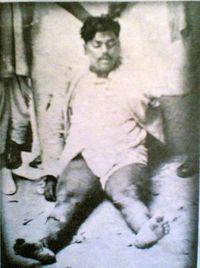 Chandrashekar Azad’s dead body kept on public display by the British to serve as a warning message |
People, even though all political parties have forgotten our great fredom fighters, let us not show such ingratitude.
Today is "Balidan Din" of grate freedom fighter Chandrashekhar Azad. HJS salute to His grate work for Dharma and Nation. Every Hindu must take inspiration from Azad and serve for Dharma and Nation. That will be the true salute to Him.
| Place of birth: | Badarka, Unnao District, Uttar Pradesh,India | |
| Place of death: | Allahabad, Uttar Pradesh, India | |
| Movement: | Indian Independence movement | |
| Major organizations: | Naujawan Bharat Sabha, Kirti Kissan Party and Hindustan Socialist Republican Association | |
Chandrashekhar Azad, often called, Pandit ji was the founder of Garam Dal. He was the first to start the revolutionary struggle with arms against the oppressive Britishers. Chandershekhar a devout brahmin believed that his dharma was to fight for others.
Chandrashekhar Azaad said a soldier never relinquishes his weapon. Hence Chandrashekhar Azaad died with his weapon in his hand fighting with British.
Involved in Kakori Train Robbery (1926), the attempt to blow up the Viceroy’s train (1926), and the shooting of John Poyantz Saunders at Lahore (1928) to avenge the killing of Lala Lajpat Rai He formed Hindustan Socialist Republican Association. He was the guru for revolutionaries such as Bhagat Singh, Sukhdev, Batukeshwar Dutt, and Rajguru.
Chandra Shekhar’s parents were Pandit Sitaram Tiwari and Jagarani Devi shifted to Bhavra villages in Jhabua District, Madhya Pradeshwhile Chandra Shekhar was a child. He received his early schooling in the same village and for higher studies he went to the Sanskrit Pathashala at Varanasi. He was an ardent follower of Hanuman and once disguised himself as a priest in a Hanuman temple to escape the dragnet of British police.
Chandrashekhar Azad was deeply troubled by the Jallianwala Bagh massacre in Amritsar in 1919. In 1921, when Mahatma Gandhi launched Non-Cooperation movement, Chandrasekhar Azaad actively participated in revolutionary activities. He received his first punishment at the age of fifteen. Chandra Shekhar was caught while indulging in revolutionary activities. When the magistrate asked him his name, he said "Azad" (meaning free). Chandrashekhar Azad was sentenced to fifteen lashes. With each stroke of the whip the young Chandrasekhar shouted "Bharat Mata Ki Jai"["Hail The Motherland!"] and "Gandhi ki Jai" ["Hail Gandhi!"] From then on Chandrashekhar assumed the title of Azad and came to known as Chandrashekhar Azad. Chandrashekhar Azad vowed that he would never be arrested by the British police and would die as free man.
After the suspension of Non-cooperation movement Chandrashekhar Azad was attracted towards more aggressive and revolutionary ideals. He committed himself to complete independence by any means. Chandrashekhar Azad and his compatriots would target British officials known for their oppressive actions against ordinary people and freedom fighters. Chandrashekhar Azad was involved in Kakori Train Robbery (1926), the attempt to blow up the Viceroy’s train (1926), and the shooting of Saunders at Lahore (1928) to avenge the killing of Lala Lajpat Rai.
Along with Bhagat Singh and other compatriots like Sukhdev and Rajguru, Chandrashekhar Azad formed the Hindustan Socialist Republican Association (HRSA). HRSA was committed to complete Indian independence and socialist principles for India’s future progress.
Chandrashekhar Azad was a terror for British police. He was on their hit list and the British police badly wanted to capture him dead or alive. On February 27, 1931 Chandrashekhar Azad met two of his comrades at the Alfred Park, Allahabad. He was betrayed by an informer who had informed the British police. The police surrounded the park and ordered Chandrashekhar Azad to surrender. Chandrashekhar Azad fought alone valiantly and killed three policemen. He got shot in the thigh. Later seeing no means of escape he shot himself with his last bullet. Thus he kept his pledge of not being caught alive.
Many of his activities were planned and executed from Shahjahanpur.
Revolutionary
Young Azad was one of the young generation of Indians when Mahatma Gandhi launched the Non-Cooperation Movement. But many were disillusioned with Gandhi’s suspension of the struggle in 1922 due to the Chauri Chaura massacre of 22 policemen. Although Gandhi was appalled by the brutal violence, Azad did not feel that violence was unacceptable in the struggle, especially in view of the Jallianwala Bagh Massacre of 1919, when the British Army units killed hundreds of unarmed civilians and wounded thousands in Amritsar which deeply influenced the young Azad and his contemporaries.
At one point he was arrested while a teenager. When asked his name by the police, he replied Azad, which means "free" in Urdu. He once claimed that, while named "Azad," he would never be taken alive by police. Azad and others had committed themselves to absolute independence by any means. He was most famous for the Kakori train robbery in 1925 and the assassination of the assistant superintendent of police, John Poyantz Saunders, in 1928. Azad and his compatriots would target British officials known for their oppressive actions against ordinary people, or for beating and torturing arrested revolutionaries.
Azad was also a believer in socialism as the basis for India’s future. He also killed himself because he got trapped by police. He felt he was azad (free) and didn’t want to be caught, so he killed himself. He also knew who told the police about him.
Source: Wikipedia.org

